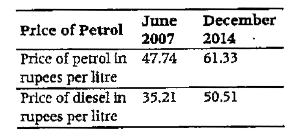Assertion : Petrol is more volatile than diesel oil.
Reason : Petrol condenses near the top of the column than diesel oil.
If both assertion and reason are true and reason is the correct explanation of assertion.
If both assertion and reason are true but reason is not the correct explanation of assertion.
If assertion is true but reason is false.
If both assertion and reason are false.
The correct Answer is:B
Topper's Solved these Questions
- COAL AND PETROLEUMBOOK - MTG IIT JEE FOUNDATIONCHAPTER - COAL AND PETROLEUMEXERCISE - EXERCISE (COMPREHENSION) LEVEL 2
12 Videos
- COAL AND PETROLEUMBOOK - MTG IIT JEE FOUNDATIONCHAPTER - COAL AND PETROLEUMEXERCISE - EXERCISE (VERY SHORT ANSWER) LEVEL 2
15 Videos
- COAL AND PETROLEUMBOOK - MTG IIT JEE FOUNDATIONCHAPTER - COAL AND PETROLEUMEXERCISE - EXERCISE (MATCH THE FOLLOWING) LEVEL 2
10 Videos
- ATOMS, MOLECULES AND ATOMIC STRUCTUREBOOK - MTG IIT JEE FOUNDATIONCHAPTER - ATOMS, MOLECULES AND ATOMIC STRUCTUREEXERCISE - EXERCISE ( Integer/Numerical Value Type)
5 Videos
- COMBUSTION AND FLAME BOOK - MTG IIT JEE FOUNDATIONCHAPTER - COMBUSTION AND FLAME EXERCISE - OLYMPIAD/HOTS CORNER
15 Videos
Similar Questions
Knowledge Check
Assertion: CNG is better than diesel/petrol
Reason: Unlike petrol or diesel, CNG burns more efficiently in the automobiles and very little of it is left unburnt.AIf both assertion and reason are true and the reason is the correct explanation of the assertionBIf both assertion and reason are true but reason is not the correct explanation of the assertionCIf assertion is true but reason is falseDIf both assertion and reason are false.When petroleum is heated in a fractionating column, various fractions are obtained at various heights of the column. More volatile liquid goes upto the top and least volatile liquid remains at the bottom. Various gaseous fractions are condensed according to their boiling points.
Which will condense near the top, petrol, diesel oil, fuel oil or kerosene?APetrolBDiesel oilCFuel oilDKeroseneStudy the following table.

After studying the above table, Devmeet a class V student, wrote the following in his notebook.
A. Petrol is a more expensive fuel than diesel.
B. The percentage increase in price of diesel is more than that of petrol.
C. Diesel is cheaper and that is why public transport runs on it.
D. Diesel is a cheaper fuel than petrol. People should buy diesel vehicles.AB and Care inferencesBC and D are inferencesCA and D are observationsDA and Care observations
How CNG is better than Diesel /Petrol ?
View SolutionCause- The government has recently increased its taxes on petrol and diesel by about 10 percent. Which of the following can be a possible effect of the above cause?
(a) The petroleum companies will reduce the price of petrol and diesel by about 10 percent.
(b) The petroleum companies will increase the prices of petrol and diesel by about 10 percent.
[c] The petroleum companies will increase the prices of petrol and diesel by about 5 percent.
(d) The petrol pump will stop selling petrol and diesel till the taxes are rolled back by the government.
(e) None of above.
View SolutionCause- The government has recently increased its taxes on petrol and diesel by about 10 percent. Which of the following can be a possible effect of the above cause?
(a) The petroleum companies will reduce the price of petrol and diesel by about 10 percent.
(b) The petroleum companies will increase the prices of petrol and diesel by about 10 percent.
[c] The petroleum companies will increase the prices of petrol and diesel by about 5 percent.
(d) The petrol pump will stop selling petrol and diesel till the taxes are rolled back by the government.
(e) None of above.
View SolutionPetrol and diesel prices will be revised on …………………
View SolutionProduction of petrol and diesel driven vehicles :
View Solution
